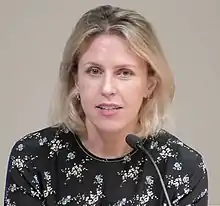Alexandra Daisy Ginsberg
Alexandra Daisy Ginsberg (born 1982)[1] is a British and South African artist who lives and works in London, UK. She is known for artworks that explore the relationship between humans, technology and nature.[2]
Alexandra Daisy Ginsberg | |
|---|---|
 Ginsberg at Columbia GSAPP in 2019 | |
| Born | Alexandra Daisy Ginsberg 1982 |
| Nationality | British, South African |
| Website | daisyginsberg |
Early life and education
Ginsberg completed an MA (Cantab) in Architecture from the University of Cambridge in 2004. She attended Harvard University as a Visiting Student between 2005 - 2006. In 2009, Ginsberg received an MA in Design Interactions at the Royal College of Art, London, UK. In 2017, Ginsberg completed a PhD at the Royal College of Art. Her thesis explored the notion of ‘better’ in relation to design and synthetic biology.[3]
Career
Ginsberg’s artworks focus on humans' relationship with the non-human world, broaching themes such as artificial intelligence,[4] synthetic biology, biodiversity, nature,[5] conservation,[6] and evolution.[7] Her background in design[8] and synthetic biology often informs her artistic practice.[9][10]
Her installations have been shown at the Centre Pompidou, Museum of Modern Art, Somerset House, Museum of Contemporary Art Tokyo and Royal Academy.[11][12] In 2021, she was commissioned by the Eden Project to create a pollinator-friendly artwork, taking the shape of gardens generated by an algorithm.[13]
Ginsberg has discussed her projects at various l institutions, including the Natural History Museum, London;[14] Serpentine Gallery, London; Royal Academy, London; Museo Nacional Thyssen-Bornemisza, Madrid; Centre Pompidou, Paris;[15] V&A Museum, London; MIT, Boston; Museum of Modern Art, New York [16] and Ted Global.[17]
She has been the recipient of awards such as Breakthrough of the Year, Science in the Arts, Falling Walls, 2020;[18] The Rapoport Award for Women in Art & Tech, 2019; Changemaker Award, Dezeen, 2019;[19] London Design Medal, 2012 and Future 50, Icon Magazine, 2013.
Collections
References
- "Alexandra Daisy Ginsberg |". The Museum of Modern Art. Retrieved 15 August 2021.
- "United Nations sounds the alarm on species loss - and artists respond". 29 May 2019. Retrieved 26 July 2021.
- "Alexandra Daisy Ginsberg". Retrieved 26 July 2021.
- "Award-Winning Artwork Uses AI-Generated Bird Song To Recreate The Dawn Chorus". Forbes. Retrieved 26 July 2021.
- "Artists create new work reflecting life during the pandemic for Edinburgh exhibition". Retrieved 26 July 2021.
- Campbell-Johnston, Rachel. "UnNatural History review — a fascinating consideration of art's relationship with the environment". Retrieved 26 July 2021.
- "Alexandra Daisy Ginsberg". Retrieved 26 July 2021.
- "How the London design scene continues to thrive". 15 October 2020. Retrieved 29 July 2021.
- "Alexandra Daisy Ginsberg – interview: 'We need to radically rethink our behaviours, globally'". Retrieved 29 July 2021.
- Saval, Nikil (28 September 2020). "Design for the Future When the Future is Bleak". The New York Times. Retrieved 29 July 2021.
- "Artist brings white rhino back from the dead, digitally". Retrieved 29 July 2021.
- Wainwright, Oliver (21 November 2019). "Eco-Visionaries review – the salt flats will die and the jellyfish shall rise". The Guardian. Retrieved 26 July 2021.
- "Working With Nature". Retrieved 29 July 2021.
- "We Need To Talk About Extinction". Retrieved 29 July 2021.
- "Forum Vertigo". Retrieved 29 July 2021.
- "Synthetic Aesthetics: New Frontiers in Contemporary Design". 4 November 2014. Retrieved 29 July 2021.
- "TEDGlobal 2011". Retrieved 29 July 2021.
- "Falling Walls". Retrieved 29 July 2021.
- "Dezeen Awards 2020 design longlist announced". 13 August 2020. Retrieved 29 July 2021.
- Art Institute of Chicago (2009). "'Growth Assembly', Alexandra Daisy Ginsberg,2009".
- Cooper Hewitt. "'Designing for the Sixth Extinction', Alexandra Daisy Ginsberg, 2013 - ongoing".
- ZKM. "ZKM Collection".